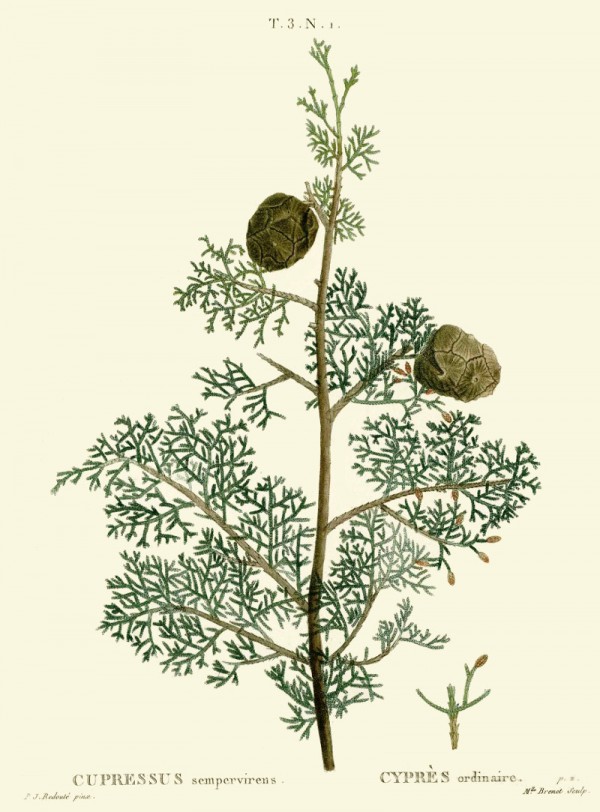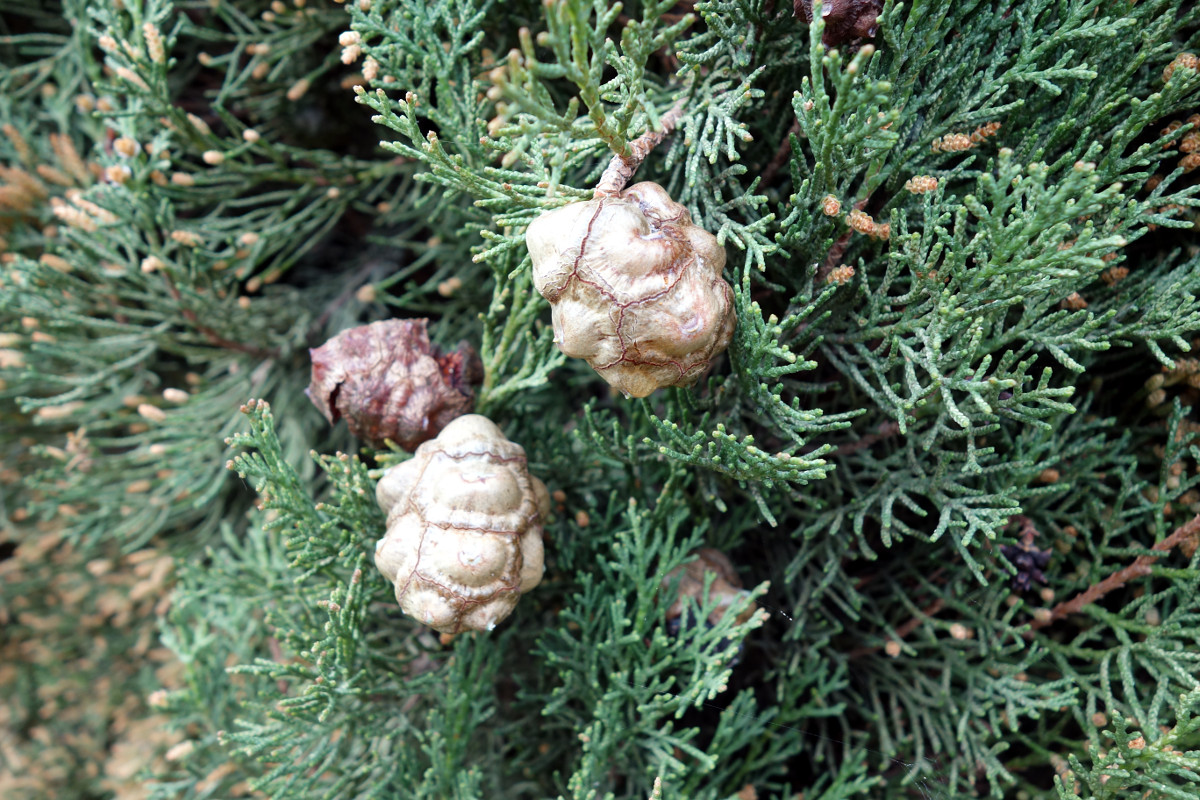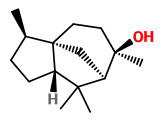Cupressus sempervirens L. - syn. Cupressus pyramidalis Targ. Tozz. - Cupressaceae
Mediterranean cypress, Italian cypress, Mittelmeer-Zypresse, Italienische Zypresse
Evergreen tree, up to 30m tall, native to the Mediterranean region; bark grayish brown, shallowly fissured; branchlets not arranged in a plane, ultimate ones 4-angled, ca. 1mm in diam.; leaves in 4 ranks, densely appressed, dark green, not glaucous, 0.5-1mm, ridged abaxially; pollen cones 4-8mm; seed cones yellowish gray when ripe, subglobose or ellipsoid, 2.5-4×2-3cm.
http://www.efloras.org/florataxon.aspx?flora_id=2&taxon_id=200005421
http://www.tropicos.org/NamePage.aspx?nameid=9400073
Cupressus sempervirens var. stricta is cultivated as an ornamental tree (Tuskany, Provence).
Cupressus sempervirens var. atlantica (Cupressus atlantica Gaussen) grews in the central parts of the Atlas Mountains.
„The wood of the Italian cypress is remarkably durable, and was much employed for making large chests for clothing, etc., in the Middle Ages, its odour, agreeable to human beings, keeping away moths.“
International Dendrological Society: Trees and Shrubs Online - Cupressus sempervirens L.
Main components of the essential oil of Cupressus sempervirens L. cones, prepared by steam distillation, were α-pinene (48.2%), δ-3-carene (19.0%), terpinolene (3.9%), cedrol (3.3%), myrcene (3.0%), limonene (2.5%), α-terpineol (2.2%), α-terpinyl acetate (2.2%), and α-fenchene (1.8%).
[Kassem, F. F., et al. „Composition of the essential oil of Egyptian Cupressus sempervirens L. cones.“ Flavour and fragrance journal 6.3 (1991): 205-207]
Essential oil from plant material collected within 12 months (1999) in the central part of Dalmatia (Croatia) showed α-pinene (28.4-79.2%) as the main component. Other important components were γ-3-carene (9.1-32.6%), α-cedrol (1.2-12.9%), limonene (1.4-8.7%), terpinolene (0.6-7.0%) and α-terpinyl acetate (0.8-4.5%).
[Seasonal Variation in Essential Oil Compositions of Cupressus sempervirens L., Milos, M., Radonic, A., Mastelic, J., Journal of Essential Oil Research, Vol.14(3), 2002, 222-223]
The essential oil of the needles and twigs of var.stricta was dominated by sabinene (39.6%) and α-pinene (19.3%); main components were also limonene (7.3%), 4-terpineol (7.3%), γ-terpinene (6.1%), α-terpinene (3.9%) and myrcene (3.4%).
[Comparative evaluation of 11 essential oils of different origin as functional antioxidants, antiradicals and antimicrobials in foods. Sacchetti, G., Maietti, S., Muzzoli, M., Scaglianti, M., Manfredini, S., Radice, M., Bruni, R., Food Chemistry, Vol.91, 2005, 621-632] http://naturalingredient.org/wp/wp-content/uploads/Comparative-evaluation-of-11-essential-oils-of-different-ori....pdf
The essential oil of the needles and twigs of var.atlantica is dominated by α-pinene (60%), with cedrol (8%), and limonene (4%).
[Chemical composition and antimicrobial activity of essential oils isolated from Algerian Juniperus phoenicea L. and Cupressus sempervirens L., Khadidja, M., Nassima, B., Chahrazed, B., Xavier, F., Journal of Medicinal Plants Research, Vol.4(10), 2010, 959-964]
The unique warm-woody agrestic-herbal scent of dried C.sempervirens wood is based on carvacryl methyl ether and α-cedrol, rounded off by bornyl acetate, terpinen-4-yl acetate, and further mono-and sesquiterpenes.
The leaf scent (headspace, trees of Bolgheri, Italia) is based on sabinene (13.5%), δ-3-carene (24.4%), limonene (6.8%), terpinolene (7.2%), and α-pinene (6.5%), and characterized by isothujone (0.1%), karahanaenone (1.2%), cis-sabinene hydrate acetate, linalool, linalyl acetate, bornyl acetate, terpinen-4-ol, α-terpinyl acetate, α-cedrol, (3E,5Z)-undeca-1,3,5-triene (0.03%, intense galbanum), and (2E,4Z)-deca-2,4-dienyl isovalerate (0.01%, juniper berry-related).
[Scent of a vanishing flora, Roman Kaiser, 2011, 146-148 and 336-337]

Duhamel du Monceau,H.L., Traité des arbres et arbustes, Nouvelle édition [Nouveau Duhamel], vol.3, t.1 (1806) [P.J.Redouté]
http://plantgenera.org/species.php?id_species=299407

Cupressus sempervirens, CC BY-SA 3.0, Author: Andreas Kraska





